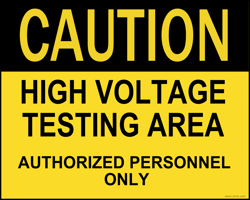Testing with high voltage can make some people nervous. Getting a high voltage error can cause panic. But is high voltage testing dangerous? Truth be told, with all the safety features built into testers, high voltage testing is hardly more dangerous than low voltage testing.
With all the high voltage safety warnings and labels, it’s easy to see why testing with high voltage would create uneasy feelings. If you don’t understand why high voltage testing is important, you may feel a little wary of it.
High voltage, or hipot testing looks for problems with the cable’s insulation. Problems with the insulation may not be found with only a low voltage test. Higher voltages can reveal defects that may otherwise be missed.
There are three common errors found during high voltage tests.
- Overcurrent – current is leaking through the insulation.
- Had Leakage – current is leaking between unconnected points.
- Dielectric Failure – voltage has arced from one of the wires.
With current leaking and voltage arcing, it’s easy to see why high voltage testing can make people a little tense. Remember that Cirris engineers make safety a top priority when designing testers. Systems are put in place to protect the user. For example, testers eliminate risk of harm by limiting the current and energy. The testers are designed to abort the high voltage test at the first sign of trouble. However, it is still best practice to train users and put emergency procedures in place.
We want all Cirris tester users to be as safe as possible during all parts of the test process, especially high voltage testing. For ideas on training and emergency procedures, check out Cirris’ article on hipot safety in our Learning Center.

Further Reading:
Charge and Overcurrent Errors
High Voltage or Low Voltage? Which Tester Should You Buy?
You Performed a High Voltage Test. Now What?